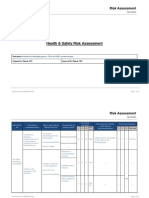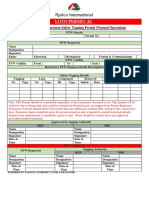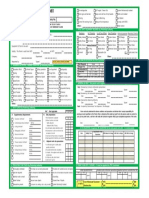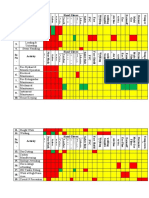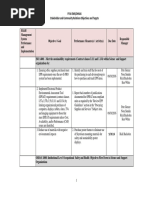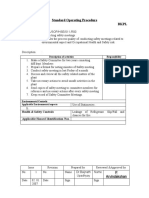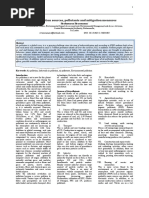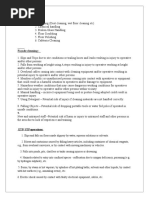Chemical Storage Guidelines Si
Chemical Storage Guidelines Si
Uploaded by
Indranil MitraCopyright:
Available Formats
Chemical Storage Guidelines Si
Chemical Storage Guidelines Si
Uploaded by
Indranil MitraOriginal Description:
Copyright
Available Formats
Share this document
Did you find this document useful?
Is this content inappropriate?
Copyright:
Available Formats
Chemical Storage Guidelines Si
Chemical Storage Guidelines Si
Uploaded by
Indranil MitraCopyright:
Available Formats
Fact Sheet
ENVIRONMENTAL
HEALTH & SAFETY
Chemical Storage Guidelines
General Storage Requirements
• Always review a chemical’s MSDS/SDS for proper storage procedures.
• Do not store glass chemical containers on the floor (without secondary
containment) or window ledges.
• Chemical storage areas should be well lit, appropriately ventilated and kept
away from aisles, exits, and heat.
• Minimize storage on the lab bench, in fume hoods, and other work areas.
• Use first-in, first-out system (oldest chemicals first); to avoid degradation of older
chemicals and their containers.
• Inspect stored chemicals often for expiration, deterioration and chemical
integrity.
Storage Shelves/Cabinets
• Ensure chemical storage shelves are securely fastened to the wall and have lips or other suitable methods to prevent bottles
from falling in the event of an earthquake.
• Avoid storing all chemicals above shoulder height. Large containers (1 gal or larger), liquids, and corrosive materials should
be stored no higher than eye level.
• Do not overcrowd shelves.
• Flammables (in excess of 10 gal) must be stored in a flammable storage cabinet.
• Label chemical storage cabinets according to the type of chemical family or hazard classification found there (Acid Storage,
Solvent Storage, etc.).
Storage in Refrigerators and Freezers
• Never store chemicals in office, domestic, or personal refrigerators; food and chemicals should never be stored together.
• When storing flammables in refrigerator, use an approved explosion proof or flammable storage refrigerator only.
• Label all refrigerator/freezers as to intended use.
• Frequently inventory materials stored in refrigerator/freezers and defrost occasionally to prevent chemicals from becoming
trapped in ice formations.
Secondary Containment
• Use secondary containment, such as polyethylene or stainless steel
trays, to separate incompatible chemicals stored in the same area and
to provide spill containment.
• Provide secondary containers for storage of solvents and concentrated
acids and bases.
• Use secondary containers during storage of all hazardous chemicals on
the floor.
Storage of Hazardous Waste
• Minimize storage of hazardous waste.
• Store hazardous waste using the same guidelines as you would for storing chemical containers; use secondary containment,
ensure the container is closed when not in use, and ensure proper labeling of the waste.
Page 1 of 2 Safety Instruction # 30 – rev. 05/2015
• If you no longer need a chemical, rather than keeping it stored, dispose of it properly (e.g. as hazardous waste) or follow the
chemical reuse guidelines.
• Maximum storage times:
- When storing untreated chemicals that degrade to unstable forms (e.g. peroxide formers such as ethyl ether), limit
maximum storage time to one year from purchase or six months from first use. Note date received/date opened on such
materials.
- For other hazardous chemicals, use manufacturer’s recommended storage time (if there is one) or other indications of
degradation (e.g. discoloring of liquids).
• Expired chemicals should not be stored or used in laboratories and should be relinquished to EH&S for disposal.
Segregating Hazardous Chemicals
Store chemicals by hazard classification; avoid storing chemicals alphabetically unless they are compatible or already separated
into appropriate hazard classes - this ensures that incompatible chemicals are segregated.
Accidental contact between incompatible chemicals can result in a fire, an explosion, the formation of highly toxic and/or flammable
substances, or other potentially harmful reactions. If incompatible chemicals must be stored in the same cabinet, be sure to provide
physical segregation (secondary containment).
Class of Recommended Storage
Examples Incompatibles
Chemicals Method
Corrosives - Inorganic Store in a corrosive storage cabinet Hydrochloric acid, sulfuric acid,
Bases and cyanides
(Mineral) Acids or in secondary containment hydrofluoric acid, phosphoric acid
Corrosives – Organic Store in a corrosive storage cabinet Acetic acid, trichloroacetic acid,
Bases and cyanides
Acids or in secondary containment lactic acid
Store in a corrosive storage cabinet Ammonium hydroxide, sodium
Corrosives - Bases Acids
or in secondary containment hydroxide
Store in secure location away from Flammable liquids,
Explosives Acetone Peroxide, Trinitrobenzene
all other chemicals oxidizers, acids and bases
Store in flammable storage cabinet
Flammable (in excess of 10 gal) within Acetone, benzene, ethanol Oxidizers
secondary containment
Store in secondary containment, Separate from reducing
Sodium hypochlorite, potassium
Oxidizers separate from flammable and agents, flammables, and
chlorate, peroxides, nitrates
combustible materials combustibles
Store in dry, cool location, protect Sodium metal, potassium metal, Separate from all aqueous
Water-Reactive
from water fire sprinkler lithium metal solution, and oxidizers
Store in cool, dry area, away from
Oxidizing and toxic
Compressed Gas - oxidizing gases. Securely strap or
Methane, acetylene, propane compressed gases,
Flammable chain cylinders to a wall or bench
oxidizing solids
top
Store in cool, dry area, away from
Compressed Gas - flammable gases and liquids.
Oxygen, chlorine, bromine Flammable gases
Oxidizing Securely strap or chain cylinders to
a wall or bench top
Note: Certain chemicals require special segregation precautions to be taken. Concentrated nitric and perchloric acids
should be stored in their own secondary containment within a corrosive storage cabinet due to oxidizing characteristics.
Amines are often flammable in addition to being corrosive and should be stored in their own secondary containment
within a chemical storage cabinet.
Page 2 of 2 Safety Instruction # 30 – rev. 05/2015
You might also like
- Pallet Jack Safety TrainingDocument21 pagesPallet Jack Safety TrainingIndranil Mitra100% (2)
- List of Operational Control ProcedureDocument2 pagesList of Operational Control Procedurebabu541No ratings yet
- DEE EHU-17-1-2 Chemical Management Procedure PDFDocument9 pagesDEE EHU-17-1-2 Chemical Management Procedure PDFFerijanto WahjudiNo ratings yet
- Safety CommitteeDocument5 pagesSafety Committee09 Anurag SahuNo ratings yet
- Checklist: Server Room/Data Center Completed Yes No N/ADocument2 pagesChecklist: Server Room/Data Center Completed Yes No N/AIndranil MitraNo ratings yet
- BioChem Midterm ProjectDocument5 pagesBioChem Midterm ProjectSelwynVillamorPatenteNo ratings yet
- Safety Observation RoundDocument6 pagesSafety Observation RoundBorislav VulicNo ratings yet
- 2019 HSE Objectives and TargetsDocument2 pages2019 HSE Objectives and TargetshidayahNo ratings yet
- ISO 45001 Clause: RequirementDocument2 pagesISO 45001 Clause: RequirementAarya Mishra TiwariNo ratings yet
- Chemical Checklist: Criteria Yes No Needs To AddressedDocument2 pagesChemical Checklist: Criteria Yes No Needs To AddressedFen RubyNo ratings yet
- Hsep-05 - Communication, Participation & ConsultationDocument6 pagesHsep-05 - Communication, Participation & ConsultationScha AffinNo ratings yet
- Division OHS Risk Register Example OfficeDocument3 pagesDivision OHS Risk Register Example OfficeWisnu KertaningnagoroNo ratings yet
- Health & Safety Risk AssessmentDocument8 pagesHealth & Safety Risk AssessmentShailendra KumarNo ratings yet
- PTW LOTO Permit To Work (B) DetailsDocument3 pagesPTW LOTO Permit To Work (B) DetailsZaki AziziNo ratings yet
- IMS ManualDocument62 pagesIMS ManualKimpoh ChaiNo ratings yet
- 048A COSHH Thinners-PaintDocument1 page048A COSHH Thinners-PaintanonNo ratings yet
- Jurong Island Cargo Tec RA Alignment of Cover Belt BC1 & BC2Document3 pagesJurong Island Cargo Tec RA Alignment of Cover Belt BC1 & BC2Anonymous kWfNFb100% (1)
- Cold Work PermitDocument1 pageCold Work PermitherdianNo ratings yet
- Cardinal Rules January 2013Document31 pagesCardinal Rules January 2013MUKANo ratings yet
- Environmental Aspects ProcedureDocument4 pagesEnvironmental Aspects ProcedureEneyo VictorNo ratings yet
- Chemical Register TemplateDocument48 pagesChemical Register TemplateJimit ShahNo ratings yet
- Punjab General Industries Private Limited Job Hazard AnalysisDocument7 pagesPunjab General Industries Private Limited Job Hazard AnalysisRohit VishwakarmaNo ratings yet
- Ppe MatrixDocument2 pagesPpe MatrixsandeepNo ratings yet
- Environmental, Occupational Health and Safety Management SystemDocument4 pagesEnvironmental, Occupational Health and Safety Management SystemAsan IbrahimNo ratings yet
- L17 Legal Requirements in EHS Dr. AndhareDocument40 pagesL17 Legal Requirements in EHS Dr. AndhareD PandeyNo ratings yet
- 1 Ehs Procedure HiraDocument6 pages1 Ehs Procedure HiraSatyajit DangeNo ratings yet
- SA8000 Measures Social Performance in Eight Areas Important To Social Accountability in WorkplacesDocument21 pagesSA8000 Measures Social Performance in Eight Areas Important To Social Accountability in WorkplacesSkr SkrNo ratings yet
- Chairperson Appointment TemplateDocument4 pagesChairperson Appointment TemplatemimiNo ratings yet
- Improvement of Al Awir Road and International City Accesses PROJECT NO: R1005/1Document10 pagesImprovement of Al Awir Road and International City Accesses PROJECT NO: R1005/1Ravi Shankar TurlapatiNo ratings yet
- Safe Use of Chemicals: 1.0 PurposeDocument10 pagesSafe Use of Chemicals: 1.0 PurposeFuzail AyazNo ratings yet
- Environmental Emergency Preparedness and ResponseDocument4 pagesEnvironmental Emergency Preparedness and ResponseAMINE ABASSI100% (1)
- Work Permit: OCP To Be Followed For Following ActivitiesDocument2 pagesWork Permit: OCP To Be Followed For Following ActivitiesKishan MauryaNo ratings yet
- OHSAS Objectives and Targets PA Rev2Document3 pagesOHSAS Objectives and Targets PA Rev2ShirleyNo ratings yet
- Eqhsms Ims Documents 2018Document10 pagesEqhsms Ims Documents 2018Satya Gopal GNo ratings yet
- BSC 5 Star AuditDocument4 pagesBSC 5 Star AuditbesteNo ratings yet
- Facility Health, Safety and Environmental Management (Hse)Document2 pagesFacility Health, Safety and Environmental Management (Hse)Syahirah NazriNo ratings yet
- PPM-FRM-GEN-079 Contractor Baseline Risk AssessmentDocument22 pagesPPM-FRM-GEN-079 Contractor Baseline Risk AssessmentbenitaNo ratings yet
- SOP For Conducting Safety MeetingsDocument1 pageSOP For Conducting Safety Meetingssaikumar selaNo ratings yet
- HSE-PRO-09-D01 0.2 - Interested Party Needs and Expectations 2020 HSE (NEW ONE)Document7 pagesHSE-PRO-09-D01 0.2 - Interested Party Needs and Expectations 2020 HSE (NEW ONE)Soufian BahmadNo ratings yet
- First Aid Kit Inventory and Inspection Card First Aid Kit InventoryDocument1 pageFirst Aid Kit Inventory and Inspection Card First Aid Kit InventoryExperienceCentre vjnrNo ratings yet
- Hazard Identification TABLEDocument6 pagesHazard Identification TABLEjason a. unNo ratings yet
- OSHMS-08 OSH Objective & Targets Program ProcedureDocument9 pagesOSHMS-08 OSH Objective & Targets Program ProcedureSrinidhi KakarlaNo ratings yet
- TGC - Ehsp - 02. Ehs Objectives & TargetsDocument4 pagesTGC - Ehsp - 02. Ehs Objectives & TargetsAhmed El SayedNo ratings yet
- OCP For Machine SafetyDocument1 pageOCP For Machine SafetyTigor Gurning100% (1)
- PPE Assessment PDFDocument2 pagesPPE Assessment PDFvinit satheNo ratings yet
- Safety ManualDocument21 pagesSafety ManualAli ImamNo ratings yet
- 5-Star Safety and Health Management System: Risk RegisterDocument3 pages5-Star Safety and Health Management System: Risk RegistersalmanNo ratings yet
- Proper Handling and Storage of Chemicals: December 2014Document54 pagesProper Handling and Storage of Chemicals: December 2014Qais AlzamelNo ratings yet
- Ohs KpiDocument41 pagesOhs KpiRenju AntonyNo ratings yet
- SGSB Training MasterlistDocument6 pagesSGSB Training MasterlistHse Consultancy SgsbNo ratings yet
- Contractor's EHSS Evaluation by PMT EHSS PK CLC Project FMO Jan 2020Document5 pagesContractor's EHSS Evaluation by PMT EHSS PK CLC Project FMO Jan 2020ManPower RecruitingNo ratings yet
- HSE Management SystemDocument12 pagesHSE Management SystemAhmed GaafarNo ratings yet
- 4.7 Accident Near Miss RecallDocument6 pages4.7 Accident Near Miss RecallShadeed MohammedNo ratings yet
- Aspect-Impact/ Hira Registry: Ccbpi Davao Plant EnvironmentDocument4 pagesAspect-Impact/ Hira Registry: Ccbpi Davao Plant EnvironmentRafhael EspinosaNo ratings yet
- Safety Committee Minutes of MeetingDocument4 pagesSafety Committee Minutes of MeetingMichael Bejiga100% (1)
- HSMC Employee Induction Procedure (Offices)Document3 pagesHSMC Employee Induction Procedure (Offices)Anonymous 4e7GNjzGWNo ratings yet
- R-16 Safety Management Review MeetingDocument2 pagesR-16 Safety Management Review MeetingSandeep Kumar100% (1)
- Sop 04 Work Permit SystemDocument10 pagesSop 04 Work Permit Systemathul subashNo ratings yet
- Procedure For Hazard Identification, Risk Assessment, and Determining ControlsDocument8 pagesProcedure For Hazard Identification, Risk Assessment, and Determining Controlsdhir.ankur100% (1)
- Incident & Accident RegisterDocument1 pageIncident & Accident Registeradil khan0% (1)
- EHS Objectives FY (20-21)Document3 pagesEHS Objectives FY (20-21)Deepak DasNo ratings yet
- Bajaj Electricals LTD: Minutes of Meeting (Safety Committee)Document3 pagesBajaj Electricals LTD: Minutes of Meeting (Safety Committee)anil kumar100% (1)
- Chemical Storage Segregation SchemeDocument3 pagesChemical Storage Segregation Schemesuko winartiNo ratings yet
- Air Pollution Sources, Pollutants and Mitigation Measures: Sivakumaran SivaramananDocument11 pagesAir Pollution Sources, Pollutants and Mitigation Measures: Sivakumaran SivaramananIndranil MitraNo ratings yet
- Hazmat 2265 EngDocument67 pagesHazmat 2265 EngriteshagarwalsterNo ratings yet
- House Keeping:: ETP/ STP OperationsDocument3 pagesHouse Keeping:: ETP/ STP OperationsIndranil MitraNo ratings yet
- OIL Quality Assessment Transformer A41Document1 pageOIL Quality Assessment Transformer A41kamal_khan85No ratings yet
- Transformer Oil Analysis: M.G.Morshad / ACM (Elect) Transformer Maintenance Division / TPS IIDocument89 pagesTransformer Oil Analysis: M.G.Morshad / ACM (Elect) Transformer Maintenance Division / TPS IIIndranil MitraNo ratings yet
- JHA Jack Hydraulic PalletDocument1 pageJHA Jack Hydraulic PalletIndranil Mitra100% (1)
- Transformer Oil Analysis: M.G.Morshad / ACM (Elect) Transformer Maintenance Division / TPS IIDocument89 pagesTransformer Oil Analysis: M.G.Morshad / ACM (Elect) Transformer Maintenance Division / TPS IIIndranil MitraNo ratings yet
- Peer-to-Peer File Sharing and Its Effects On The World: Written and Presented By: Craig SchweitzerDocument27 pagesPeer-to-Peer File Sharing and Its Effects On The World: Written and Presented By: Craig SchweitzerIndranil MitraNo ratings yet
- Averages (Mean, Median, and Mode) Instruction SheetDocument5 pagesAverages (Mean, Median, and Mode) Instruction SheetIndranil MitraNo ratings yet
- As Reported by Mint On TuesdayDocument2 pagesAs Reported by Mint On TuesdayIndranil MitraNo ratings yet
- The Best Way To Experience The WebDocument11 pagesThe Best Way To Experience The WebIndranil Mitra100% (1)
- A Short Form of The Autonomy Scale: Properties of The Autonomy-Connectedness Scale (ACS-30)Document10 pagesA Short Form of The Autonomy Scale: Properties of The Autonomy-Connectedness Scale (ACS-30)Indranil MitraNo ratings yet
- Alcohol, Phenol & Ether - ChemistryDocument156 pagesAlcohol, Phenol & Ether - ChemistryYoshitha Kuntumalla100% (2)
- Factors Affecting The Assimilation of NitrogenDocument15 pagesFactors Affecting The Assimilation of Nitrogencsir qnNo ratings yet
- 10 5923 J Ajoc 20160602 02 PDFDocument27 pages10 5923 J Ajoc 20160602 02 PDFtuấn anhNo ratings yet
- Class 12 Chemistry 2024-25 Notes Chapter - 6. Haloalkanes and HaloarenesDocument64 pagesClass 12 Chemistry 2024-25 Notes Chapter - 6. Haloalkanes and HaloarenesGopu Ramana ReddyNo ratings yet
- Grignard ReactionDocument1 pageGrignard ReactionKenneth StackNo ratings yet
- GD-10-Calculations in IP v1.1Document30 pagesGD-10-Calculations in IP v1.1cavalo2080No ratings yet
- ProteinsDocument89 pagesProteinsResty De Guzman SoteloNo ratings yet
- Skintec Price List 2019Document2 pagesSkintec Price List 2019Melieza Melody Ampan100% (1)
- Chemistry Project:: Analysis of HoneyDocument16 pagesChemistry Project:: Analysis of HoneyDARKRAI GAMINGNo ratings yet
- Iso 6869 2000Document11 pagesIso 6869 2000Manh Tien NgoNo ratings yet
- Haloalkane - by @MadXAbhiOfficial - HandBookDocument8 pagesHaloalkane - by @MadXAbhiOfficial - HandBooksr.enterprises.4651No ratings yet
- 2010-01-Trafotech2010 TRF Oil Specifications For Indian TRF Industry PDFDocument9 pages2010-01-Trafotech2010 TRF Oil Specifications For Indian TRF Industry PDFVishnu ShankerNo ratings yet
- Chemistry 2025 (E)Document52 pagesChemistry 2025 (E)C.M.D . GGNo ratings yet
- June 2016 (IAL) MS - Unit 5 Edexcel ChemistryDocument31 pagesJune 2016 (IAL) MS - Unit 5 Edexcel ChemistryLeo DennisNo ratings yet
- CEH Linear Alpha Olefins Sample Report 2010Document78 pagesCEH Linear Alpha Olefins Sample Report 2010Mohammed Babatin0% (1)
- Acidity of WaterDocument6 pagesAcidity of WaterSabaNo ratings yet
- Gold Leaching From Oxide Ores in Alkaline Glycine SolutionsDocument10 pagesGold Leaching From Oxide Ores in Alkaline Glycine SolutionsBgo HassanNo ratings yet
- Haloalkane & Haloarenes CHEMHACKDocument8 pagesHaloalkane & Haloarenes CHEMHACKashutoshkumar110920No ratings yet
- Ii Pu Phy & Che Objective Test-08 SolutionsDocument16 pagesIi Pu Phy & Che Objective Test-08 Solutionssbn066559No ratings yet
- Unit 16 Topic 1 ESTIMATION OF SERUM PROTEIN BY BIURET METHODDocument2 pagesUnit 16 Topic 1 ESTIMATION OF SERUM PROTEIN BY BIURET METHODAhijit DeNo ratings yet
- Ionic EquilibraDocument16 pagesIonic EquilibraPankaj JindamNo ratings yet
- Test For CARBOHYDRATESDocument7 pagesTest For CARBOHYDRATESSoham N100% (2)
- (Inorganic) (Organic) (Organic)Document4 pages(Inorganic) (Organic) (Organic)Space MonkeyNo ratings yet
- Thin Layer Chromatography AssessmentDocument4 pagesThin Layer Chromatography AssessmentCHARITYNo ratings yet
- Chemistry Practical File (WSD E-Book)Document36 pagesChemistry Practical File (WSD E-Book)dhruvsinghal679% (14)
- Chemistry (The Mole)Document44 pagesChemistry (The Mole)Aisya AnwarNo ratings yet
- MCE IGCSE Chemistry SB C13 - Full SolutionsDocument3 pagesMCE IGCSE Chemistry SB C13 - Full SolutionssaniedhaNo ratings yet
- Ch103 Alcohols and Phenols: Based On Mcmurry'S Organic Chemistry, 7 EditionDocument40 pagesCh103 Alcohols and Phenols: Based On Mcmurry'S Organic Chemistry, 7 EditionEvelyn MushangweNo ratings yet
- Answer All Questions in This Section: Electrode System EDocument9 pagesAnswer All Questions in This Section: Electrode System EChang DiNo ratings yet












